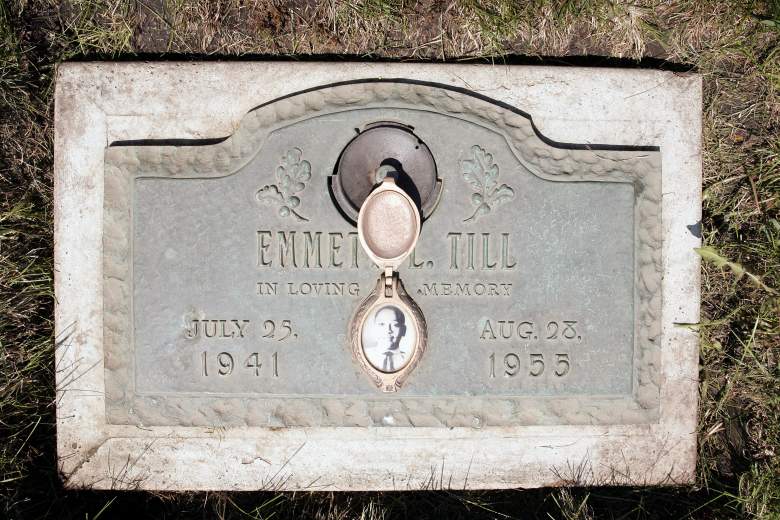
Emmett Till’s gravesite in Aslip, Illinois. (Getty)
On the morning of August 24, 1955, Emmett Till, a 14-year-old black child from Chicago, skipped church in Money, Mississippi and went to a local grocery store. While there, he saw Carolyn Bryant, the 21-year-old white woman who owned the store with her husband Roy Bryant. Till whistled or flirted with Bryant. On the morning of August 28, 1955, Till was taken from the house he was staying at in Money and killed. Roy Bryant and his half-brother J. W. Milam were acquitted of the murder, but later admitted to it in Look Magazine.
Bryant never talked about her role in the murder, which would go on to spark the Civil Rights movement, until 2007, when she spoke with author Timothy Tyson. Ahead of the publication of Tyson’s book, The Blood of Emmitt Till, his interview with her is finally going public. On January 26, Vanity Fair published the story of Tyson’s surprising interview.
In the interview, Bryant admitted that the story she told during the trial was a lie.
Here’s what we know about Bryant and her role in the Till story.
1. Bryant Says It’s ‘Not True’ That Till Made Verbal or Physical Advances Towards Her
Carolyn Bryant Donham, who divorced Roy Bryant and married two more times, testified that on August 24, 1955, Till grabbed her hand as he went to pay for bubble gum. “How about a date, baby?” Till said, according to Bryant’s testimony, which was delivered without the jury present. As Douglas O. Linder writes, Bryant claimed Till grabbed her by the waist and said he told her that he had done an “unprintable word” to “white women before.” “I was just scared to death,” Bryant said.
After delivering her testimony, Judge Curtis Swango ruled that it was inadmissible, but the all-white jury had probably heard the story before.
Now, Bryant told Tyson that this part of her testimony was not true. “That part’s not true,” she told Tyson, reports Vanity Fair. She also told Tyson that she could not remember what else happened in the grocery store that day.
At the time of her interview with Tyson, Bryant was 72. She is still alive is now 82 yeas old. Her family wants to keep her current location private and she has not done any further interviews.
2. Bryant Is Writing Her Own Memoirs, Which Won’t Be Made Public for Another 30 Years
Tyson told Vanity Fair that she approached him because she is writing her own memoirs. The manuscript is being kept at the Southern Historical Collection at the University of North Carolina Chapel Hill library. The public won’t get to read them until 2036, Tyson told the magazine.
Tyson said that Bryant’s daughter was impressed by his book Blood Does Sign My Name, which was also about a murder involving racism. The author said that she had changed, but she hasn’t repented. For example, she won’t go to the Emmett Till Interpretive Center in Sumner, Mississippi.
“She was glad things had changed [and she] thought the old system of white supremacy was wrong, though she had more or less taken it as normal at the time,” Tyson told Vanity Fair.
Bryant told Tyson that she “felt tender sorrow” for Till’s mother, Mamie Till-Mobley, who fought for civil rights and died in 2003.
3. J.W. Milam & Roy Bryant Later Confessed to Killing Till in Look Magazine
On September 23, 1955, J.W. Milam and Bryant’s husband, Roy Bryant, were acquitted of murder after the jury deliberated for just 67 minutes.
In 1956, Bryand and Milam told their story in the Look Magazine piece “The Shocking Story of Approved Killing In Mississippi” by William Bradford Huie. They were reportedly paid between $3,600 and $4,000 to talk with Huie. Huie didn’t ask the two men the questions, it was their own attorneys. Since double jeopardy prevented them from being tried again, they spoke freely, admitting to shooting Till and killing him.
“I’m no bully; I never hurt a nigger in my life. I like n***ers — in their place — I know how to work ’em. But I just decided it was time a few people got put on notice,” Milam said in Look. “As long as I live and can do anything about it, n***ers are gonna stay in their place. N***ers ain’t gonna vote where I live. If they did, they’d control the government.”
Huie later said that Milam did most of the talking and their lawyers hadn’t even heard the story. “J.W. Milam did the killing,” Huie later said, notes PBS. “He fired the shot when they took Till down on the river and killed him.”
4. Milam’s Widow Thought Carolyn Bryant Fabricated the Story That Led to Till’s Death
After the Look Magazine confession was published, the country was shocked by what the half-brothers said. According to the Jackson Clarion-Ledger’s obituary of Juanita Milam, the two were rejected by friends and supports. The Milams ended up moving to a new farm in another part of Mississippi. Huie later did another story, a year later, in which he wrote that Roy Bryant and Milam still didn’t feel guilt for killing Till.
By this point, two years after Till’s death, Milam struggled to even find land to rent. He eventually got help from a brother-in-law in Mississippi, but later moved to Texas. A few years after that, they moved to Greenville, Mississippi.
According to the Clarion-Ledger, Milam later faced criminal charges for bad checks, assault and using a stolen credit card. He died on December 31, 1980 at age 61 from spinal cancer. His widow, Juanita Milam, died in 2014. The Clarion-Ledger reported that there were rumors the Milams divorced, but there was no record of that.
Juanita Milam didn’t believe Carolyn Bryant’s story. When the FBI re-opened the Till case in 2004, Juanita Milam gave the following comment:
The only way I can figure it is that she did not want to take care of the store. She thought this wild story would make Roy take care of the store instead of leavin’ her with the kids and the store. … the only thing to me would upset her would be if she wanted Roy to stay at the store more.
5. Rosa Parks Said She Thought of Emmett Till When She Refused to Give Up Her Seat on a Bus
On December 1, 1955, less than five months after Emmett Till’s murder and two months after the verdict, Rosa Parks refused to move to the back of a bus in Montgomery, Alabama. As PBS notes, Parks said she was thinking of Till at that moment. “I thought of Emmett Till, and I just couldn’t go back,” Parks said. Parks’ story caught the attention of the NAACP and the Montgomery Bus Boycott began, sparking the Civil Rights movement.
Till’s murder continues to be a major influence in literature and culture, with books still being written about it. In 2015, Devery S. Anderson published the massive Emmett Till: The Murder That Shocked the World and Propelled the civil Rights Movement. John Edgar Wideman’s Writing to Save a Life, which is about Till’s father, was a finalist for the National Book Critics Circle Award.
Jay Z, Will Smith, Casey Affleck and producer Aaron Kaplan are also producing a series based on Anderson’s book for HBO. Deadline reported that Steven Caple Jr. (The Land) will write the miniseries.

